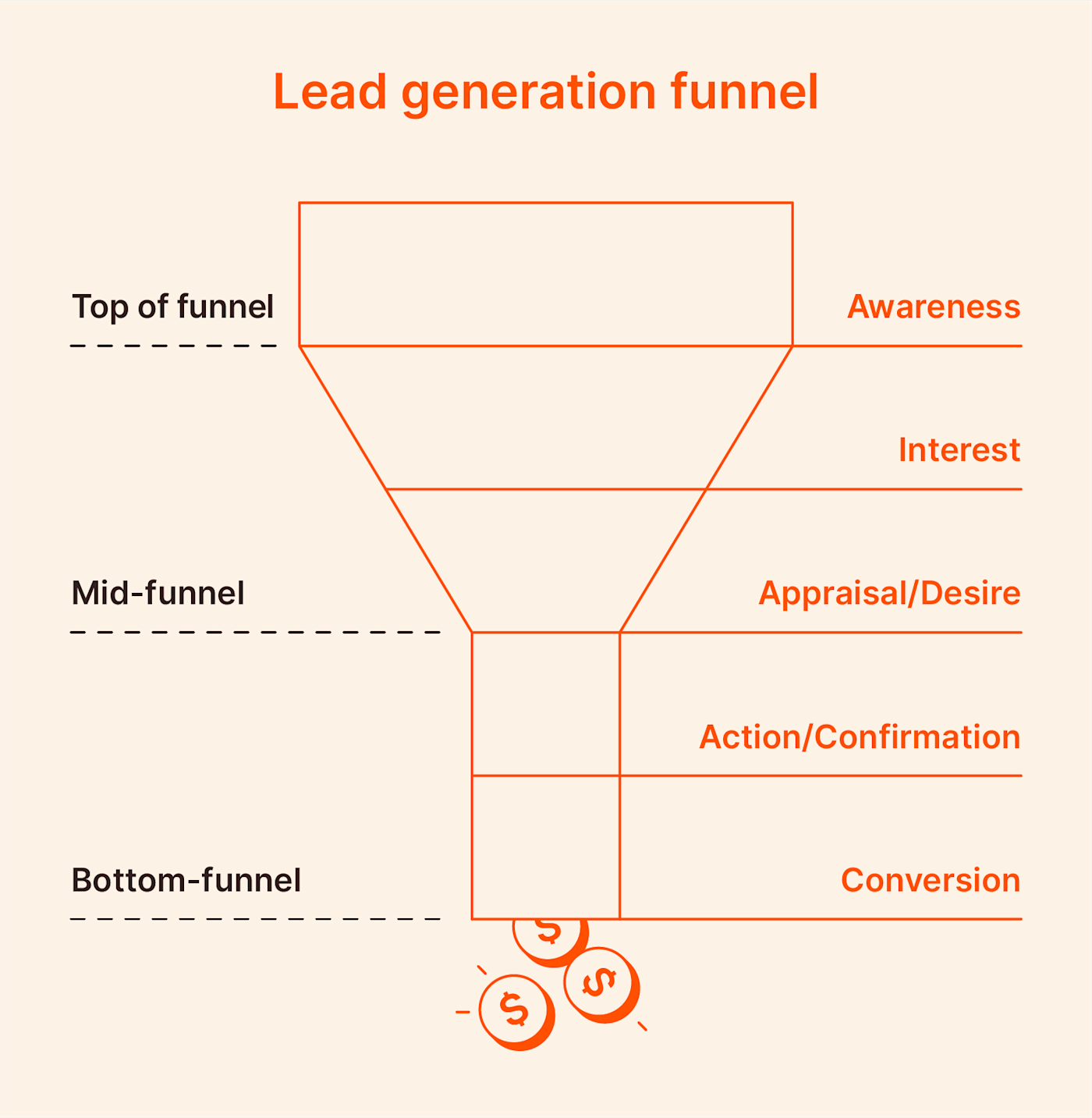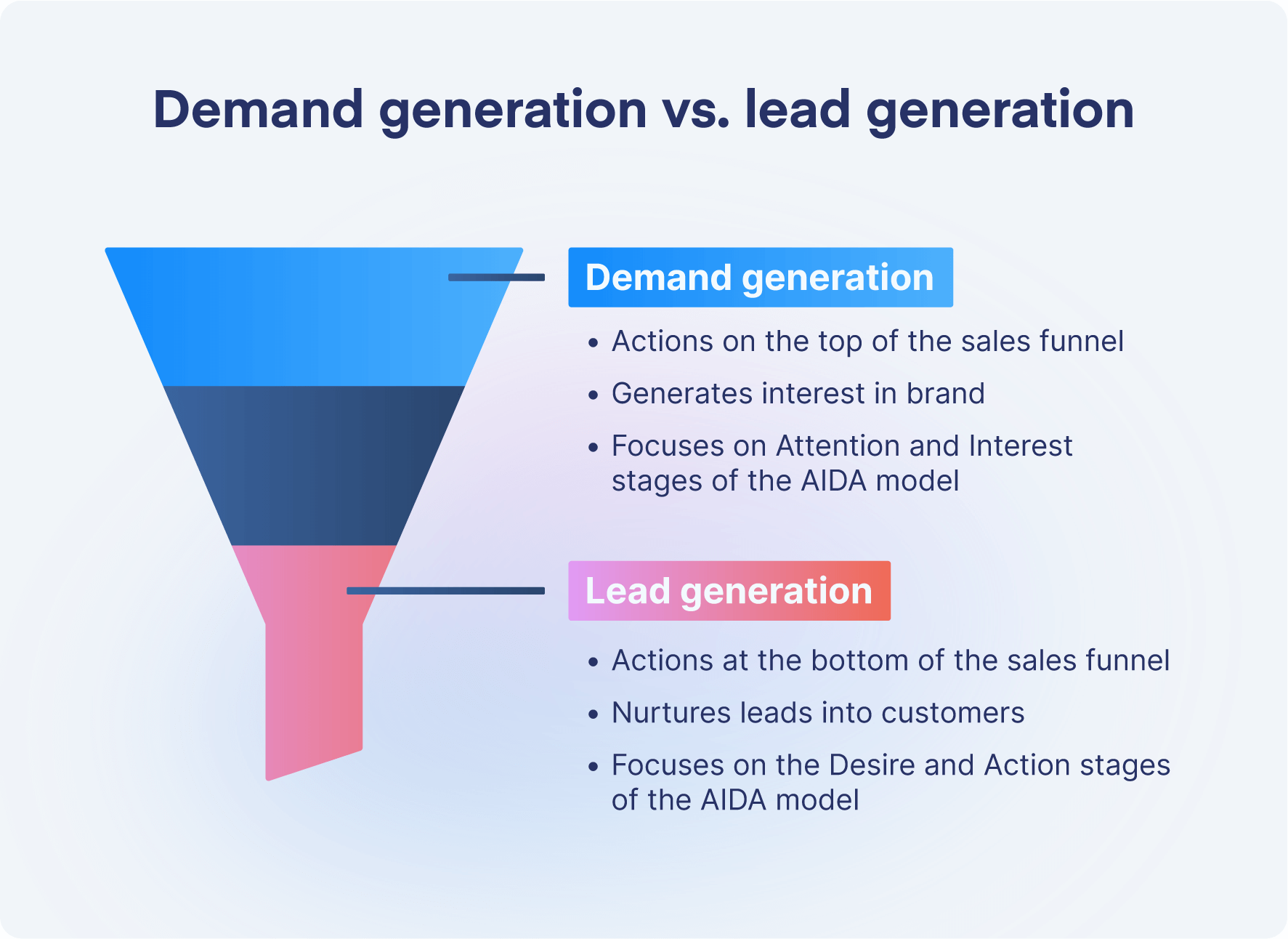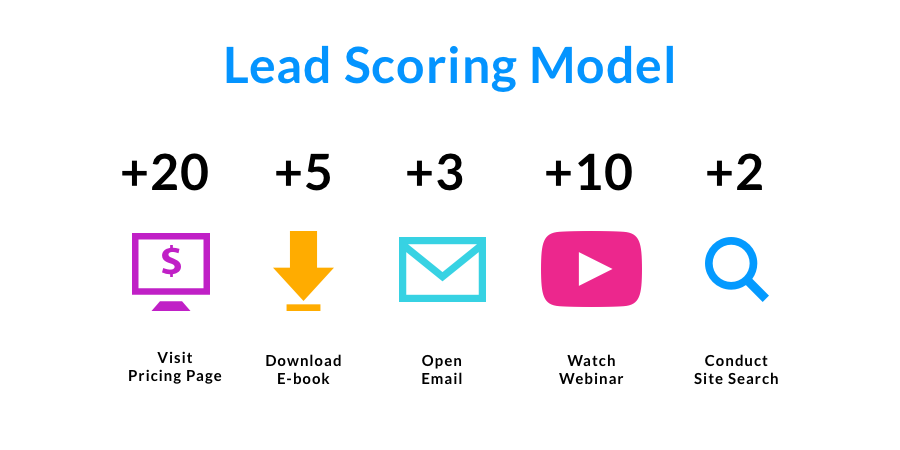Quick Links:
Every year, tons of money is spent on direct marketing and lead generation in the United States alone.
As a small business owner, you know that generating quality leads is crucial for sales.
Without a steady stream of prospects entering your pipeline, growth would stop.
Smart marketers aggressively hunt for leads using inbound and outbound tactics. They carefully nurture each lead by sharing helpful content that builds awareness and trust.
With the right lead gen strategy, you can attract great prospects, get their contact info, turn cold leads hot, and increase profits.We’ve covered how you can maximize your real estate lead generation strategy with Ylopo before, but today we'll walk you through proven broader lead generation techniques to help you create compelling offers, optimize website conversion, leverage digital ads, and integrate sales and marketing - all to drive huge business growth.
This guide covers everything beginners need to know about generating quality leads. You'll learn:
What is a lead - definition and types of leads
Lead generation process and sales funnel
Lead generation strategies and techniques
Lead scoring and qualification
Lead nurturing and management
Lead generation tools and software
Tips for an effective lead generation system
Chapter 1: What is a Lead? Definition and Types
Simply put, a lead is a potential customer who is interested in your business' products or services.
Leads are contacts you can nurture and turn into paying customers.Here are some common definitions of a lead:
A lead is someone who has shown interest in your offering. They've given you their contact info and permission to follow up.
A sales lead is a possible consumer of a product or service who expresses interest. Leads give sales teams potential new business opportunities.
Marketing defines leads as contacts who aren't customers yet but are being nurtured toward a sale.
Investor leads are potential investors that investment companies can contact about making an investment.
So in a nutshell, a lead is someone who is interested in your business and agreed to receive more info. They are prospects you can build relationships with, educate, pitch to, and hopefully turn into customers.
Types of Leads
Leads can be split into three categories:
Cold Leads
Cold leads have had zero prior interaction with your brand. They probably found your website, ad or content but didn't engage further.
Since they are total strangers, cold leads require a lot of nurturing.
Lead nurturing can turn 20-40% of cold leads into customers.Warm Leads
Warm leads have shown some interest in your business by engaging with your content. They have given you their contact info by subscribing to your newsletter, downloading an ebook/whitepaper or registering for a webinar.
Since they already know your brand, they require less nurturing than cold leads.
About 40-60% of warm leads can convert to sales.
Hot Leads
Hot leads are actively researching solutions to their problem which your product/service can solve. They have expressed specific interest by requesting a demo, free trial or quote.
Some even contact your sales team directly.
Hot leads usually just require a sales call to convert, with 60-80% becoming customers.
Lead temperature shows sales-readiness. While cold leads require a lot of nurturing, hot leads are ready to buy.
Businesses need lead generation strategies to turn cold leads into warm leads, and eventually hot leads.
Chapter 2: Lead Generation Process and Sales Funnel

Source: Zapier
Lead generation is a crucial process that fuels your sales pipeline.
It focuses on attracting and capturing new potential leads into your sales funnel.
The sales funnel is a model that depicts your customer's journey from initial awareness to becoming a paying customer. It has these stages:
Top of Funnel (TOFU)
This first stage focuses on lead generation tactics to attract strangers and convert them into leads. TOFU activities include:
Content creation - blogs, videos, guides, ebooks
Guest posting outreach
Webinars
Quality content and digital media help capture contact details of interested prospects to turn them into leads.
Middle of Funnel (MOFU)
The middle stage nurtures leads by building awareness, trust and interest in your brand. MOFU tactics include:
Lead nurturing emails
Product demos or free trials
Customized content offers
Social media engagement
Lead nurturing establishes your authority and converts cold leads into warmer leads.
Bottom of Funnel (BOFU)
The final stage focuses on converting warm and hot leads into paying customers. BOFU activities revolve around:
Product demos
Proposals and quotes
Consultative sales calls
Email/call followups
Case studies and testimonials
Special offers or discounts
This process moves qualified, sales-ready leads smoothly down the funnel into your customer pipeline.
Lead generation powers the top of your sales funnel. So to grow your business, focus on expanding lead generation campaigns and nurturing those leads until they convert.
Demand Generation vs. Lead Generation

Source: Clearbit
Another way to look at the funnel is to view the stages in terms of their timing and impact on a potential customer.
Demand generation campaigns, like a movie trailer, generate interest and anticipation. They showcase what's available and spark curiosity.
Lead generation engages directly to convert that curiosity into commitment.
While awareness attracts, acquisition retains, ensuring a smooth journey from intrigue to loyal customer.
Chapter 3: Lead Generation Strategies and Techniques
There are many lead generation strategies and tactics businesses can use to attract ideal customers. The key is to use a targeted mix of inbound and outbound approaches.
Inbound Lead Generation
Inbound lead generation centers on creating valuable content to attract prospects to your brand. Common inbound tactics include:
Content Marketing
Blog posts, videos, whitepapers and guides help establish authority and gain organic visibility. Content should focus on solving audience problems.
SEO
Optimizing your website and content for relevant keywords will help you rank higher in search and get found by prospects.
Social Media Marketing
Engaging your niche on social platforms like Facebook, LinkedIn and Twitter builds awareness and generates leads. Social ads allow targeted promotions too.
Webinars & Online Events
Hosting live or recorded webinars is a great way to capture leads through educational content.
Email Marketing
Build an email subscriber list to nurture with updates, offers, and relevant content.
The benefit of inbound lead generation is earned media, free traffic, and interested prospects volunteering their info. But it requires lots of content creation efforts.
Outbound Lead Generation
Outbound strategies involve more direct outreach to connect with potential customers. Popular outbound tactics are:
Cold Calling: Phone calls to prospects help qualify leads, cross-sell or upsell existing customers.
Email Outreach: Mass email campaigns promote your offering and attract new leads. But avoid spamming.
Direct Mail Marketing: Physical brochures, postcards and letters creatively engage prospects. Include calls-to-action.
Print advertising: Placing ads in industry magazines or local papers also works for niche B2B or regional exposure.
Networking Events: In-person events provide opportunities to connect and capture leads through conversations.
While outbound strategies are more aggressive, they may turn off prospects if not done right. Balance outbound campaigns with inbound content.
How to Generate Quality Leads
Here are proven tips to generate quality leads that drive sales:
Offer Lead Magnets: Free, valuable content offers like guides, templates, quizzes in exchange for an email address. eBooks, whitepapers, toolkits, sample demos make great lead magnets.
Promote Offers on Landing Pages: Create dedicated landing pages highlighting your lead magnet. Use persuasive copy focused on customer needs. Offer the content download in exchange for an email or phone number.
Optimize Website Navigation: Make it easy for visitors to find and claim lead magnets. Prominently display download buttons, pop-ups and contact forms to capture leads.
Grow Your Email List: Embed lead capture forms across your website to grow your list. Send educational and promotional emails to turn cold leads hot.
Run Targeted PPC Ads: Well-optimized Google/Bing/Social ads put your offers in front of people already searching for your products/services.
Engage Social Followers: Use hashtags, tagging and promoted posts to get your content in front of an interested audience. Add links back to your website offer.
Guest Blog on Niche Sites: Get exposure among industry publications or complementary blogs. Convert readers into leads with value-add content and CTAs back to your site.
Network at Industry Events: Identify relevant conferences or meetups where your prospects gather. Showcase your expertise through sessions or casual networking.
Leverage Partnerships and Referrals: Strategic business partnerships provide access to new lead sources. Tap into existing customers for referrals and introductions too.
Consistency and persistence are key - test multiple strategies and see what resonates best. Track conversions to double down on what works.
Chapter 4: Lead Scoring and Qualification

Source: Leadfuze
Lead scoring helps you gauge a lead’s sales readiness and qualification criteria using a standard rating system.
This allows you to prioritize and focus sales efforts on hot leads who can convert quickly.
Lead scoring is based on Demographic and Behavior scoring, with points assigned to each element.
Total score reflects how sales-qualified a lead is.
Demographic Scoring
Demographics cover key background details to identify ideal customer profiles:
Company (ideal size or industry)
Job title and role
Location
Purchase authority or budget
Leads matching target demographics get higher points.
Other options like annual revenue, growth rate, funding status etc can also be scored for B2B leads.
Behavior Scoring
This tracks prospect engagement or activity on your website and marketing campaigns:
Page visits
Content downloads
Email opens/clicks
Form fills
Demo requests
Leads who are more engaged and interested get higher behavior scores.
Lead Scoring Framework
A sample scoring criteria may be:
Title (CEO/CMO/Director): 25 points
Visited Pricing Page: 15 points
Clicked on Ad: 10 points
Opened Email: 5 points
Downloaded eBook: 10 points
Leads with over 50 points are hot, 25-50 are warm, and under 25 are cold leads. Prioritize sales efforts on qualified leads with highest scores.
Scoring models vary by business, so define criteria that signal buyer intent for your offerings.
Adjust scores for leads who eventually convert to further refine the framework.
Proper lead scoring ensures you focus sales efforts on qualified prospects first. It also helps identify promising leads for further nurturing across the sales funnel.
Chapter 5: Lead Nurturing and Management
Lead nurturing is building ongoing relationships with prospects to turn cold leads into sales-ready leads over time.
The goal is to move leads down the sales funnel by addressing their needs and concerns through targeted content and communications. Avoid high-pressure product pitches. Instead, nurture leads by:
Personalizing Messages: Segment leads and send content speaking to their individual interests, industry or company. Personalized emails have much higher transaction rates.
Providing Value: Share useful tips, insights and resources like whitepapers, videos and webinars to demonstrate expertise. Avoid self-promotion.
Automating Workflows: Set up automated email sequences that send relevant content to leads. For example - send pricing guide to prospects who viewed pricing pages.
Reminding Gently: If leads go quiet, send occasional check-in emails or calls to revive interest. But avoid over-communication that may annoy.
Tracking Responses: Gauge interest levels based on email opens, content downloads and page visits. Double down on what resonates.
Listening First: Ask leads qualifying questions to understand needs. Then tailor messaging and offers accordingly.
Following Up: Sales team must follow up quickly with hot leads, within 24 hours for warm leads and after a week for cold leads. Quick follow-ups increase conversions.
With effective nurturing, leads either convert over time or identify themselves as unqualified to remove from pipeline.
This saves sales bandwidth for hot leads.
Lead management CRMs like Hubspot, Salesflare and Follow Up Boss help segment, track and nurture prospects at scale.
For agents, effective lead nurturing platforms can significantly improve conversion rates."
Chapter 6: Lead Generation Tools and Software
Leveraging the right tools and software enables effective management of the end-to-end lead generation process:
Landing Page Builders: Ylopo, Leadpages and Instapage help create high-converting landing pages for lead gen offers.
Email Marketing Software: Mailchimp, Constant Contact, AWeber and ConvertKit help design email campaigns and automated nurturing sequences.
Marketing Automation Software: HubSpot, Marketo and Pardot allow you to score leads and set nurturing triggers based on behaviors.
CRMs: Follow Up Boss, Zoho and Insightly help capture leads, track interactions and manage pipelines to boost conversions.
Analytics Software: Google Analytics, Mixpanel, and Kissmetrics offer data insights to optimize lead capture and nurturing.
Ad Management Platforms: Google Ads, Facebook Business Manager and Adroll make it easy to set up and optimize PPC campaigns.
Live Chat Widgets: Drift, Tidio, Intercom let visitors or leads instantly chat with sales reps to get questions answered.
Form Builders: JotForm, Wufoo, Google Forms help create web forms, surveys and quizzes to capture lead data.
Webinar Software: GoToWebinar, Demio, Zoom enable hosting interactive online events to generate and nurture leads.
Social Media Publishing Tools: Buffer, Hootsuite, Sprout Social simplify social media lead generation efforts.
Integrating specialized tools for each step of the funnel results in a streamlined, scalable lead generation system. Assess your needs and explore options.
Chapter 7: Tips for an Effective Lead Generation System
Here are proven tips for a successful lead generation system:
Define Your Audience - Build buyer personas identifying your ideal customer’s needs, behaviors and demographics. Tailor lead gen and content strategies to their interests.
Diversify Lead Channels - Use a mix of inbound (content, SEO) and outbound (ads, calls) strategies across different digital platforms and traditional media based on personas.
Focus on High ROI Tactics - Analyze conversion rates and scale up high-performing lead channels, campaigns and strategies. Cut non-performing tactics.
Create Valuable Lead Magnets - Offer something highly useful/interesting to motivate sharing contact details, like guides, templates, quizzes etc.
Promote Offers Via Paid Ads - Run paid promotions across Google, Facebook, Instagram etc to get lead magnets in front of motivated users searching relevant keywords.
Capture Leads Across Your Website - Place email signup boxes, contact forms and downloads everywhere to reduce barriers.
Incentivize Referrals - Encourage existing customers to refer contacts. Social proof helps convert leads.
Use Retargeting Campaigns - Retarget visitors who left without opting-in via ads to capture leads.
Nurture Leads with Value-add Content - Move prospects down the funnel with relevant emails, offers, guides, webinars and newsletters.
Track Conversion Rates - Use UTM tags and analytics to track lead sources and conversion rates. Improve underperforming assets.
With a tactical lead generation process and sales integration, you can convert more prospects into customers and grow your business.
Chapter 8: Common Challenges and How to Overcome Them
Low Conversion Rates
One of the most frustrating challenges in lead generation is attracting website traffic but seeing minimal conversions.
Imagine a hundred visitors landing on your page, yet only one or two sign up for your offer.
The culprit often lies in poor optimization of landing pages or ineffective calls-to-action (CTAs).
Many beginners underestimate the importance of aligning the content on their landing page with the needs of their audience.A generic offer or vague CTA like "Click Here" doesn't inspire action.
To tackle this, refine your landing page to focus on a single, compelling offer.
Use actionable language in your CTAs, such as "Get My Free Guide Now," to prompt engagement.
Test variations of headlines, button colors, and page layouts using A/B testing tools to identify what resonates most with your audience.
Even small tweaks—like reducing form fields—can significantly boost conversion rates.
Attracting the Right Leads
Even if you generate leads, they may not always be the right ones.
Many businesses face the issue of attracting contacts who don't fit their ideal customer profile, resulting in wasted time and resources.
For instance, a company selling high-end software might receive inquiries from small businesses unable to afford their solution.
This mismatch often stems from poorly targeted marketing efforts.
To ensure you're attracting qualified leads, leverage data-driven tools to define your audience clearly.Platforms like Facebook Ads Manager or Google Ads allow you to narrow targeting based on demographics, interests, and behaviors.
For B2B businesses, use LinkedIn's advanced filters to focus on job titles, company sizes, and industries that align with your offerings.
Building detailed buyer personas ensures that your messaging and targeting remain focused on high-potential prospects.
Balancing Costs and ROI
Generating leads isn't free, and for small businesses, the cost per lead (CPL) can quickly spiral out of control.
Paid advertising campaigns, while effective, often become expensive without a well-defined strategy.Businesses often find themselves spending hundreds of dollars on clicks that don't translate into meaningful leads, let alone sales.
To maximize ROI, start small with your ad budget and test campaigns meticulously before scaling.
Use conversion tracking tools like Google Analytics or Meta Pixel to measure results.
Combine these insights with a strong inbound strategy—such as creating evergreen content that generates organic leads over time.
When you balance your inbound and outbound efforts, you can reduce dependence on high-cost channels while still maintaining a steady lead flow.
Keeping Leads Engaged Through Nurturing
One common mistake is assuming that a lead is sales-ready the moment you capture their contact information.
Many leads, especially those in the early stages of their buyer journey, need time and nurturing to build trust in your brand.
Without proper follow-up, these leads may lose interest or forget about you entirely.
Implementing an automated nurturing system can help keep your brand top of mind.
Email sequences triggered by a lead's behavior—such as downloading an eBook or visiting your pricing page—deliver personalized, timely messages that guide prospects further down the funnel.
Complement these efforts with retargeting ads, reminding visitors of your offerings and encouraging them to re-engage.Overcoming Technology Gaps
For beginners, managing the entire lead generation process can feel overwhelming without the right tools.
Trying to juggle email campaigns, landing pages, CRM systems, and analytics manually often leads to inefficiencies and missed opportunities.
The challenge is compounded when businesses aren't sure which tools to invest in or how to use them effectively.Start by identifying your biggest bottlenecks.
If you struggle with capturing leads, prioritize a tool like Leadpages or Instapage for building optimized landing pages.
If lead management is an issue, adopt a user-friendly CRM like HubSpot or Follow Up Boss.
Don't hesitate to invest in training or online tutorials to make the most of these tools.
The right technology stack simplifies your workflow, making your lead generation efforts more scalable and productive.
Final Thoughts
Mastering lead generation may seem complex at first for beginners.
However, by starting with buyer personas, ramping up high ROI tactics, capturing leads across digital channels and nurturing prospects effectively - small businesses can build a repeatable system to turn strangers into leads and leads into happy customers.
Track conversions diligently to double down on what works. Keep testing new strategies and innovating your offers.
Effective lead generation is an ongoing brand building exercise, not a one-time tactic.Over time, you will build consumer awareness, trust and engagement.
Lead generation paired with great products, services and support is the growth engine driving all successful customer-centric businesses today.
Unlock Your True Lead Gen Potential with Ylopo
Picture your real estate business accelerating, fueled by exclusive, high-intent leads from cutting-edge tech.
Envision dominating the market, effortlessly converting qualified prospects into delighted clients.
This vision can be your reality.
Ylopo's revolutionary end-to-end platform delivers game-changing lead gen, nurturing, and automation that leaves old-school methods behind.Top producers nationwide already rely on Ylopo's unrivaled ROI.
Now it's your turn.
Book a FREE demo and prepare for your powerhouse breakthrough.
In minutes, you'll grasp how Ylopo empowers you to shatter boundaries and achieve your biggest goals.
The future starts now; seize it by experiencing the life-changing power of Ylopo.










